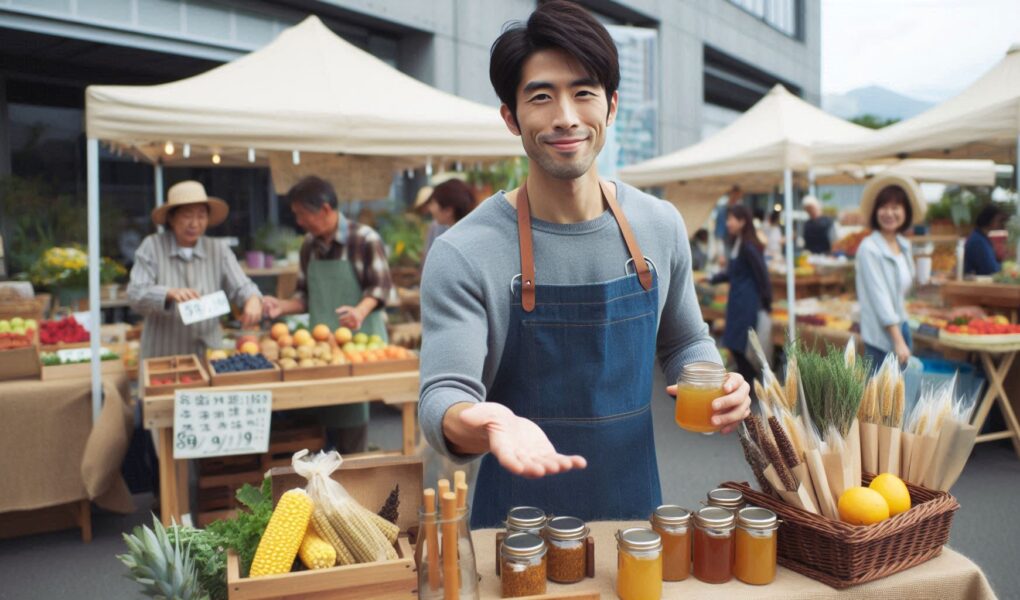Over my decade of marketing artisanal food products, I’ve tested every sampling approach imaginable – grocery store demos, street festivals, even door-to-door. But nothing compares to the conversion power of a well-executed farmer’s market sampling campaign.
Here’s why:
Farmer’s markets attract exactly the kind of customers small food brands dream about:
- Intentional shoppers who allocate time specifically to discover new products
- Local food enthusiasts with above-average willingness to pay for quality
- Community-oriented buyers who take pride in supporting small producers
The numbers prove it: According to Farmers Market Coalition data, regular market shoppers spend 38% more on specialty foods than conventional grocery shoppers. Even better?
A Nielsen study found in-person sampling increases purchase intent by up to 75% when done correctly.
But here’s what most first-time vendors get wrong – they treat sampling as just handing out free product. In reality, it’s a sophisticated marketing funnel that requires strategy at every stage. Let me walk you through the complete system I’ve developed across 200+ market days.
Step 1: Selecting Your Ideal Farmer’s Market (The Make-or-Break Decision)
Not all markets are created equal. Choosing the wrong one can mean wasting hundreds in vendor fees and product. Here’s how to analyze markets like a pro:
Market Research Tactics That Work
1. The Recon Visit
- Attend 3-4 potential markets as a shopper first
- Arrive at peak hours (usually 9-11am)
- Bring a notepad to track:
- Demographic breakdown (age, family status, etc.)
- Competing products
- Where foot traffic naturally flows
2. Vendor Intelligence Gathering
- Politely ask other vendors:
“What’s your average sales per market day?”
“How’s the crowd been this season?” - Observe which booths have consistent lines
3. Online Sleuthing
- Check market websites for attendance stats
- Review Facebook/Instagram tags to see real visitor photos
- Search local press for market features
Key Selection Criteria
Green Flags:
✓ 500+ weekly visitors
✓ Similar product price points to yours
✓ At least 3 complementary (not competing) vendors
✓ Engaged market manager who promotes vendors
Red Flags:
✗ Less than 200 regular shoppers
✗ Multiple direct competitors already present
✗ Poor social media presence
✗ History of vendor turnover
Pro Tip: Start with weekday markets if possible – they often have lower vendor fees but still good traffic from retirees and remote workers.
Step 2: The Complete Compliance Checklist (Don’t Get Shut Down!)
I learned this lesson the hard way when health inspectors temporarily closed my first sampling booth over a $25 permit I didn’t know I needed. Here’s everything to verify:
Required Documentation
1. Health Department Permits
- Temporary Food Service Permit (varies by state)
- Food Handler Certification (often required for staff)
- Product Ingredient List (for allergen verification)
2. Market-Specific Requirements
- Vendor insurance (usually $1M general liability)
- Sales tax registration
- Sampling approval forms
3. Product-Specific Regulations
- Cottage food laws (if homemade)
- Organic certification paperwork (if making claims)
- Nutritional labeling (if packaged)
Timeline for Compliance
8 Weeks Out:
- Apply for temporary food permits
- Order insurance certificates
4 Weeks Out:
- Complete market applications
- Train staff on food safety
1 Week Out:
- Print multiple permit copies
- Prepare allergy disclaimer signs
Step 3: Booth Design Psychology (Convert More Samplers)
Through A/B testing at dozens of markets, I’ve identified booth elements that consistently increase sampling conversion:
High-Impact Design Elements
1. The 3-Second Rule Layout
- Place samples at 42″ height (optimal eye level)
- Use a “power triangle” formation:
- Samples front/centre
- Products for sale at right
- Sign up sheet at left
2. Colour Psychology Choices
- Green = natural/fresh (great for produce)
- Red = appetite stimulation (ideal for sweets)
- Brown = artisan/rustic (perfect for baked goods)
3. Conversion-Boosting Signage
Instead of just “Samples Here”, try:
- “92% of tasters buy! Will you?”
- “Our bestseller – try it free”
- “Limited samples remaining!”
Real-World Example
A client selling small-batch hot sauce increased conversions 40% by:
- Adding a “Heat Challenge” sign
- Using red-checked tablecloths
- Placing samples on miniature tortilla chips (instead of plain cups)
Step 4: The Perfect Sampling Script (Word-for-Word Templates)
After analyzing hours of booth interactions, I developed this foolproof sampling sequence:
The 4-Part Sampling Conversation
1. The Hook (0-3 seconds)
“Have you tried a honey-infused hot sauce before?”
[Intriguing question that demands response]
2. The Hand off (4-7 seconds)
“Most people are surprised by how the sweetness balances the heat – here’s a taste!”
[Give sample while describing]
3. The Qualifier (8-12 seconds)
“Do you usually prefer mild or bold flavors?”
[Engage in micro-conversation]
4. The Transition (13-20 seconds)
“Since you liked that, you’ll love our mango-habanero – it’s our bestseller with market regulars. Want to try it?”
[Upsell to second sample]
Handling Common Objections
“I’m just browsing”
→ “No pressure! If you change your mind, we’re here all day. What caught your eye?”
“I don’t like [ingredient]”
→ “Interesting! What don’t you like about it? Our version is different because…”
Step 5: Converting Samples to Sales (Proven Tactics)
The fatal mistake? Assuming samplers will automatically buy. You need strategic incentives:
The Conversion Trifecta
1. Time-Sensitive Offers
“Take 15% off if you buy in the next 20 minutes”
[Creates urgency]
2. Bundle Deals
“Any 3 for 20″(whensingleis8)
[Increases average order value]
3. Loyalty Builders
“Buy today and get a free sample pack next visit”
[Drives repeat business]
Payment Processing Tips
- Always carry $50 in small bills for change
- Use Square Reader for cards
- Set up Apple/Google Pay
- Have Venmo QR code displayed
Step 6: Post-Market Follow Up System
The fortune is in the follow-up. Here’s my exact email sequence:
Day 0 (Same Evening)
Subject: “Thanks for stopping by [Market Name]!”
Body: Friendly thank you + coupon code
Day 3
Subject: “You left this behind at our booth…”
Body: Playful reminder about un-purchased items
Day 7
Subject: “Last chance for your market discount”
Body: Final urgency push
Advanced Tactics for Seasoned Vendors
Once you’ve mastered the basics, try these pro moves:
Data-Driven Sampling
- Track conversion rates by:
- Time of day
- Sample type
- Staff member
- Use findings to optimize future markets
Collaborative Marketing
- Partner with complementary vendors for cross-promotions
- “Try the perfect pairing – our jam with their artisan bread!”
Final Thoughts
Running a successful sampling campaign requires equal parts preparation, psychology, and persistence. But when done right, farmer’s markets offer the most cost-effective customer acquisition channel for food businesses.
Remember: Every sample is a miniature first date with your brand. Make it memorable, make it delightful, and most importantly – make it easy to say yes to a second date (aka purchase).
What’s your biggest farmer’s market challenge?
I’d love to help troubleshoot – drop your question below!

